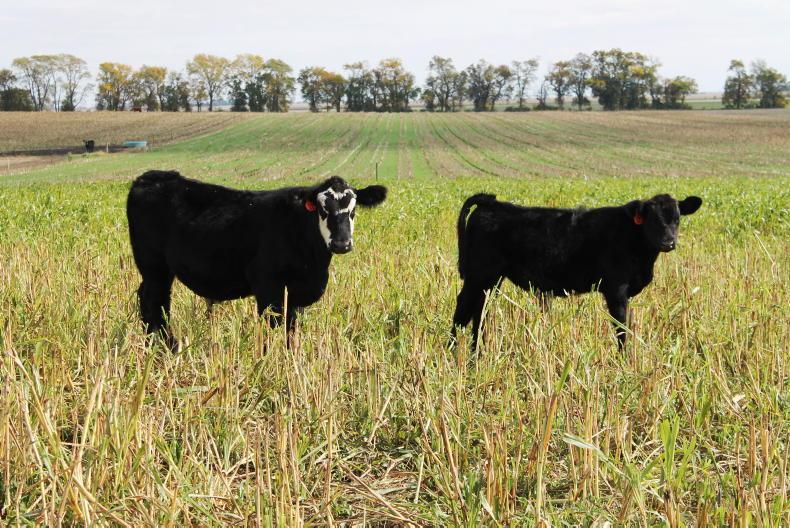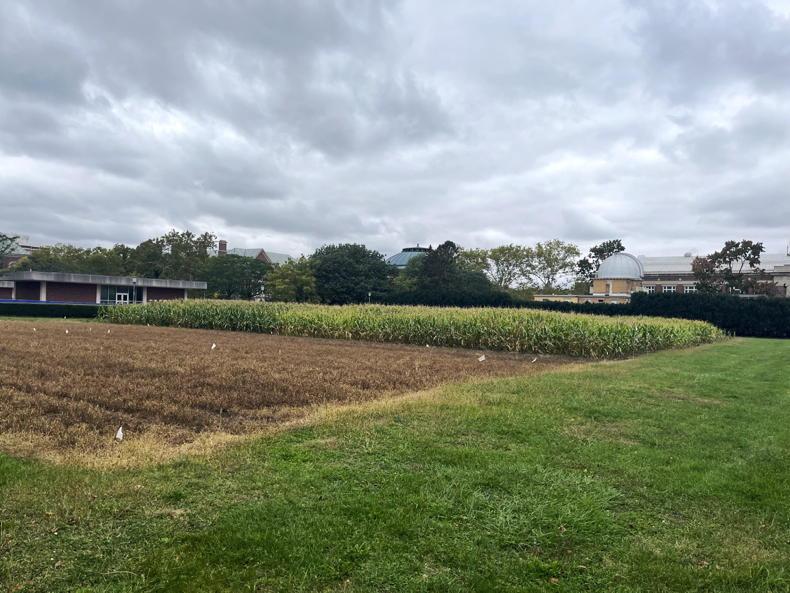Conservation is still considered “a nice-to-have” in US farm policy as crop insurance and direct subsidies continue to command priority funding in the reauthorisation of the next US Farm Bill, a leading US agricultural policy expert has outlined.
Jonathan Coppess, associate professor of agricultural policy and law at the University of Illinois at Urbana-Champaign (UIUC) – who worked directly on two former Farm Bills (2008 and 2014) – says a lack of political will and historical policy lapses have prevented American farms from achieving greater conservation status.
It comes as the latest reform of the US Farm Bill – which has an estimated budget of some $1.51 trillion for the next 10 years – has endured months of congressional chaos due to a complex process of negotiations on programme funding.
The bill generally expires and is renewed at five-year intervals.
Speaking to the Irish Farmers Journal in his office at UIUC’s Department of Agricultural and Consumer Economics, located in the heart of the US corn belt region, the former federal policymaker reflected and projected on the capacity of the Farm Bill’s conservation policy to enable farmers and ranchers working cropland to improve water quality, reduce soil erosion, and enhance wildlife habitats over the coming years.

Jonathan Coppess, associate professor of agricultural policy and law, at the University of Illinois at Urbana-Champaign. \ Claire McCormack
“Typically, we have broader political support for conservation than farm subsidies, this comes back time and time again in surveys, but the way the system works complicates progress,” said Assoc Prof Coppess.
“Firstly, commodity interest groups go up to Capitol Hill to push for policy changes that benefit farmers financially, that’s one side.
“The second part is historical. Conservation policy in the US has grown under a limited-spending mindset.
“It was largely ignored from the 1930s to 1950s and really only began to be permanently included since 1985, but it is that time frame since 1985 where it has been limited by budget issues; so there was a long historical lag and when it finally made it into the bill permanently, the budget limited the scope and funding.

Conservation agriculture practiced on the corn, soya bean and beef farm of Dirk and Matt Rice (father and son) in Philo, Illinois. \ Claire McCormack
“We tried to do an open-ended programme in 2002 but Congress came back and drastically cut it again to save money so there’s the ongoing impact of these weird dynamics that have made the timing more difficult to expand conservation policy.
“Today it’s ‘a-nice-to-have’ in our policy space. If we have the funding, we’ll put it in there, but we’ve never prioritised it, the budget limitations are just too strict and too difficult politically to overcome.”
The former administrator of the Farm Service Agency at the US Department of Agriculture (USDA), native of a corn and soya bean farm in Ohio and author of well-known book The Fault Lines of Farm Policy, says the opposite is the case for the other two pillars of the Farm Bill – crop insurance and direct farm payments.
“Crop insurance has grown consistently; it is now roughly $10bn a year. Around 80% to 85% goes out in subsidising costs to the farmer of buying an insurance policy. So, when there is a drought or weather event, you get reimbursement for losses based on the policy purchased. This has grown to be the biggest pillar of the Farm Bill.
“The farm support payment programme really varies. If prices are high, we spend very little. If prices are low, we spend significant amounts.
“The payments are decoupled and many farmers treat it as a bonus, you never rely on it. If you get an extra $15,000 at the end of the year, you just plough it back into the operation.

Jonathan Coppess, associate professor of agricultural policy and law, at the University of Illinois at Urbana-Champaign. \ Claire McCormack
“But the conservation side is different, we really restrict it. We only allow about $2bn a year for the Environmental Quality Incentives Programme (EQIP); and $1bn per year for the Conservation Stewardship Progamme (CSP).
“On average, around twice as many farmers want conservation assistance from the USDA but only about half the applications get approved because there’s not enough money. There is strong demand for the programme, but farmers just can’t get in.”
The academic, whose next book Between Soil & Society examines the legislative history and political development of Farm Bill conservation policy, says the CSP was designed to really push farmers to innovate and expand conservation across their holdings.
“It’s very much built on improving conservation, reducing soil erosion and nutrient losses, helping with practices like grassed waterways, streams and other buffers.
“Grasslands have their own conservation policy and are generally for grazing whereas the CSP is mostly for working cropland.
“But Congress has continually cut the programme back to where it’s now a fraction of what it would have been.
“Lobbyists will fight to the bitter end to make sure crop insurance doesn’t get hurt, they will battle it out regionally to make sure subsidy payments are protected, but conservation just doesn’t have that direct interest group pushing for it,” he said.
According to the policy expert, who writes extensively on this topic for UIUC’s FarmDoc platform, funding levels for the CSP are expected to fall to less than $500m per year with spending projections by the congressional budget office to drop even further – even though the pot was once expected to grow beyond $2bn per year.
Furthermore, the Conservation Reserve Program, the oldest conservation program in the Farm Bill has seen its acreage capped from 45m acres during the reauthorisation of the 1990 policy, to 27m acres by the 2018 Farm Bill.

The Morrow Plots is an experimental agricultural field at the University of Illinois Urbana-Champaign. \ Claire McCormack
Currently, the total area of US farmland used to produce crops is around 330m acres, according to the USDA’s Farms and Land in Farms report for 2022. However, this figure probably also includes grazing lands, pasture, forage, and forestry.
Assoc Prof Coppess says the situation has become very frustrating for producers and has had serious implications for the country’s environment and natural resources.
Agriculture accounts for about 10% of US greenhouse gas emissions, according to the US Environmental Protection Agency.
“A direct consequence of this ongoing capping on conservation is that there is now a large backlog in the number of farmers who want to do conservation, which means we don’t get as much farm conservation and then we struggle to address our natural resource issues.
“Every summer we have a ‘dead zone’ [too little oxygen to support marine life] in the Gulf of Mexico because of nutrient fertilisers that get washed out of fields and into the Gulf.”
Struggle
“Since 2015, Illinois has had a strategy to try to address it but it’s a struggle. It’s very difficult to get practices adopted and maintained effectively over the large acreage scope that we need.
“We’ve been pushing for the adoption of cover crops for many years but less than 10% of the acres in the state are probably using it.
“Although we’ve made some progress on soil erosion, this spring we had a tragedy on our interstate during planting season when a massive dust storm kicked across and people were killed in car wrecks on the highway because we have no cover or windbreaks holding the soil down.
“Nutrient losses are one of the most prominent natural resource challenges that we have in this part of the country too. We’re losing phosphorus and nitrogen to lakes, rivers and water bodies and we just continue to struggle widely with this.
“We’re also seeing more pressures around wildlife and pollinators. There was a lot of concern about the Monarch Butterfly, for example.
“Ultimately, when we limit the funding and limit the political outcomes then we limit the practices,” he said.
The farmer vote for Trump
Asked if he expects a strong farmer vote for Donald Trump if the former president – who provided record government subsidies to farmers during his 2017-2021 term – is successful in his bid to run for the 2024 US presidential election, Assoc Prof Coppess replied:
“All we know at the moment is polling results show he continues to have strength in rural America, which would include a significant number of farmers.
“I also know farmers who did not, and will not, vote for him.
“As for the previous payments, I think that would be a factor. Farmers are likely to recall that he issued large amounts of payments but also disrupted trade.”
Conservation policy
Asked how another Trump presidency could potentially impact Farm Bill conservation policy into the future, he replied: “I would say with another Trump presidency all bets are off. I don’t see a scenario in which his return to the White House wouldn’t have catastrophic consequences for our system of government and our actions on climate change.

Jonathan Coppess, associate professor of agricultural policy and law, at the University of Illinois at Urbana-Champaign. \ Claire McCormack
“I believe we would see a further significant shift away from sustainability and conservation.
“But they would have to be careful on this too because you still have demand from farmers to improve the conservation status of their farms and consumers here are starting to have higher expectations for conservation measures to be used on farms too.
“Under another Biden presidency, we’d probably see a continued push towards addressing climate change and probably some incremental increased spending in conservation to improve on that, but I still don’t see any major shift in the Farm Bill in the short term because it’s so difficult to push it through Congress.”
Conservation is still considered “a nice-to-have” in US farm policy as crop insurance and direct subsidies continue to command priority funding in the reauthorisation of the next US Farm Bill, a leading US agricultural policy expert has outlined.
Jonathan Coppess, associate professor of agricultural policy and law at the University of Illinois at Urbana-Champaign (UIUC) – who worked directly on two former Farm Bills (2008 and 2014) – says a lack of political will and historical policy lapses have prevented American farms from achieving greater conservation status.
It comes as the latest reform of the US Farm Bill – which has an estimated budget of some $1.51 trillion for the next 10 years – has endured months of congressional chaos due to a complex process of negotiations on programme funding.
The bill generally expires and is renewed at five-year intervals.
Speaking to the Irish Farmers Journal in his office at UIUC’s Department of Agricultural and Consumer Economics, located in the heart of the US corn belt region, the former federal policymaker reflected and projected on the capacity of the Farm Bill’s conservation policy to enable farmers and ranchers working cropland to improve water quality, reduce soil erosion, and enhance wildlife habitats over the coming years.

Jonathan Coppess, associate professor of agricultural policy and law, at the University of Illinois at Urbana-Champaign. \ Claire McCormack
“Typically, we have broader political support for conservation than farm subsidies, this comes back time and time again in surveys, but the way the system works complicates progress,” said Assoc Prof Coppess.
“Firstly, commodity interest groups go up to Capitol Hill to push for policy changes that benefit farmers financially, that’s one side.
“The second part is historical. Conservation policy in the US has grown under a limited-spending mindset.
“It was largely ignored from the 1930s to 1950s and really only began to be permanently included since 1985, but it is that time frame since 1985 where it has been limited by budget issues; so there was a long historical lag and when it finally made it into the bill permanently, the budget limited the scope and funding.

Conservation agriculture practiced on the corn, soya bean and beef farm of Dirk and Matt Rice (father and son) in Philo, Illinois. \ Claire McCormack
“We tried to do an open-ended programme in 2002 but Congress came back and drastically cut it again to save money so there’s the ongoing impact of these weird dynamics that have made the timing more difficult to expand conservation policy.
“Today it’s ‘a-nice-to-have’ in our policy space. If we have the funding, we’ll put it in there, but we’ve never prioritised it, the budget limitations are just too strict and too difficult politically to overcome.”
The former administrator of the Farm Service Agency at the US Department of Agriculture (USDA), native of a corn and soya bean farm in Ohio and author of well-known book The Fault Lines of Farm Policy, says the opposite is the case for the other two pillars of the Farm Bill – crop insurance and direct farm payments.
“Crop insurance has grown consistently; it is now roughly $10bn a year. Around 80% to 85% goes out in subsidising costs to the farmer of buying an insurance policy. So, when there is a drought or weather event, you get reimbursement for losses based on the policy purchased. This has grown to be the biggest pillar of the Farm Bill.
“The farm support payment programme really varies. If prices are high, we spend very little. If prices are low, we spend significant amounts.
“The payments are decoupled and many farmers treat it as a bonus, you never rely on it. If you get an extra $15,000 at the end of the year, you just plough it back into the operation.

Jonathan Coppess, associate professor of agricultural policy and law, at the University of Illinois at Urbana-Champaign. \ Claire McCormack
“But the conservation side is different, we really restrict it. We only allow about $2bn a year for the Environmental Quality Incentives Programme (EQIP); and $1bn per year for the Conservation Stewardship Progamme (CSP).
“On average, around twice as many farmers want conservation assistance from the USDA but only about half the applications get approved because there’s not enough money. There is strong demand for the programme, but farmers just can’t get in.”
The academic, whose next book Between Soil & Society examines the legislative history and political development of Farm Bill conservation policy, says the CSP was designed to really push farmers to innovate and expand conservation across their holdings.
“It’s very much built on improving conservation, reducing soil erosion and nutrient losses, helping with practices like grassed waterways, streams and other buffers.
“Grasslands have their own conservation policy and are generally for grazing whereas the CSP is mostly for working cropland.
“But Congress has continually cut the programme back to where it’s now a fraction of what it would have been.
“Lobbyists will fight to the bitter end to make sure crop insurance doesn’t get hurt, they will battle it out regionally to make sure subsidy payments are protected, but conservation just doesn’t have that direct interest group pushing for it,” he said.
According to the policy expert, who writes extensively on this topic for UIUC’s FarmDoc platform, funding levels for the CSP are expected to fall to less than $500m per year with spending projections by the congressional budget office to drop even further – even though the pot was once expected to grow beyond $2bn per year.
Furthermore, the Conservation Reserve Program, the oldest conservation program in the Farm Bill has seen its acreage capped from 45m acres during the reauthorisation of the 1990 policy, to 27m acres by the 2018 Farm Bill.

The Morrow Plots is an experimental agricultural field at the University of Illinois Urbana-Champaign. \ Claire McCormack
Currently, the total area of US farmland used to produce crops is around 330m acres, according to the USDA’s Farms and Land in Farms report for 2022. However, this figure probably also includes grazing lands, pasture, forage, and forestry.
Assoc Prof Coppess says the situation has become very frustrating for producers and has had serious implications for the country’s environment and natural resources.
Agriculture accounts for about 10% of US greenhouse gas emissions, according to the US Environmental Protection Agency.
“A direct consequence of this ongoing capping on conservation is that there is now a large backlog in the number of farmers who want to do conservation, which means we don’t get as much farm conservation and then we struggle to address our natural resource issues.
“Every summer we have a ‘dead zone’ [too little oxygen to support marine life] in the Gulf of Mexico because of nutrient fertilisers that get washed out of fields and into the Gulf.”
Struggle
“Since 2015, Illinois has had a strategy to try to address it but it’s a struggle. It’s very difficult to get practices adopted and maintained effectively over the large acreage scope that we need.
“We’ve been pushing for the adoption of cover crops for many years but less than 10% of the acres in the state are probably using it.
“Although we’ve made some progress on soil erosion, this spring we had a tragedy on our interstate during planting season when a massive dust storm kicked across and people were killed in car wrecks on the highway because we have no cover or windbreaks holding the soil down.
“Nutrient losses are one of the most prominent natural resource challenges that we have in this part of the country too. We’re losing phosphorus and nitrogen to lakes, rivers and water bodies and we just continue to struggle widely with this.
“We’re also seeing more pressures around wildlife and pollinators. There was a lot of concern about the Monarch Butterfly, for example.
“Ultimately, when we limit the funding and limit the political outcomes then we limit the practices,” he said.
The farmer vote for Trump
Asked if he expects a strong farmer vote for Donald Trump if the former president – who provided record government subsidies to farmers during his 2017-2021 term – is successful in his bid to run for the 2024 US presidential election, Assoc Prof Coppess replied:
“All we know at the moment is polling results show he continues to have strength in rural America, which would include a significant number of farmers.
“I also know farmers who did not, and will not, vote for him.
“As for the previous payments, I think that would be a factor. Farmers are likely to recall that he issued large amounts of payments but also disrupted trade.”
Conservation policy
Asked how another Trump presidency could potentially impact Farm Bill conservation policy into the future, he replied: “I would say with another Trump presidency all bets are off. I don’t see a scenario in which his return to the White House wouldn’t have catastrophic consequences for our system of government and our actions on climate change.

Jonathan Coppess, associate professor of agricultural policy and law, at the University of Illinois at Urbana-Champaign. \ Claire McCormack
“I believe we would see a further significant shift away from sustainability and conservation.
“But they would have to be careful on this too because you still have demand from farmers to improve the conservation status of their farms and consumers here are starting to have higher expectations for conservation measures to be used on farms too.
“Under another Biden presidency, we’d probably see a continued push towards addressing climate change and probably some incremental increased spending in conservation to improve on that, but I still don’t see any major shift in the Farm Bill in the short term because it’s so difficult to push it through Congress.”











 This is a subscriber-only article
This is a subscriber-only article










SHARING OPTIONS: